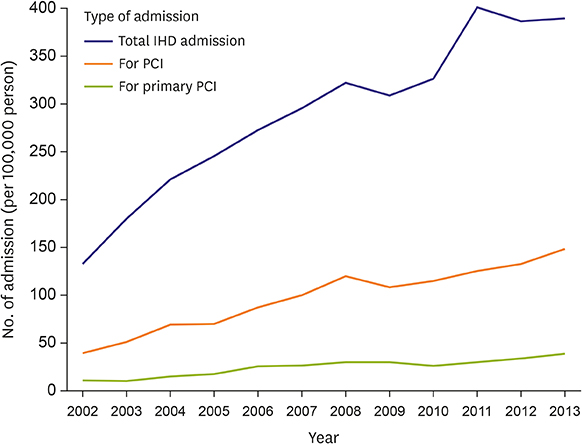Korean Circ J.
2019 Dec;49(12):1155-1163. 10.4070/kcj.2019.0080.
Descriptive Study on the Korean Status of Percutaneous Coronary Intervention Using National Health Insurance Service-National Sample Cohort (NHIS-NSC) Database: Focused on Temporal Trend
- Affiliations
-
- 1Division of Cardiology, Department of Medicine, Prevention & Rehabilitation Center, Heart Vascular & Stroke Institute, Samsung Medical Center, Sungkyunkwan University School of Medicine, Seoul, Korea. jdsung@skku.edu
- KMID: 2464295
- DOI: http://doi.org/10.4070/kcj.2019.0080
Abstract
- BACKGROUND AND OBJECTIVES
Percutaneous coronary intervention (PCI) is an indispensable treatment modality in coronary artery disease. However, there is still inadequacy of comprehensive knowledge on the Korean status and trend of this important procedure using nation-wide and representative data.
METHODS
National Health Insurance Service-National Sample Cohort is a database containing demographic, health insurance reimbursement for patient management and health screening data of about one million Koreans for 12 years (2002-2013). Annual procedure rate for PCI was estimated by bootstrapping as per 100,000 person-years.
RESULTS
Among the whole cohort, total 12,186 PCI's were done during the study period. Mean age of subjects who underwent PCI was 57.6±11.2 years and male:female proportion was 68%:32%. Death from all cause occurred in 1,843 (15.1%), death from ischemic heart diseases in 662 (5.4%), death from all cardiovascular cause in 872 (7.2%) during the follow-up. The proportion of the primary PCI for acute myocardial infarction was estimated to be 24.0%. Estimated annual rate of PCI increased from median 29.1 (95% confidence interval [CI], 26.6-32.1) in 2002 to 107.7 (95% CI, 103.0-113.8) per 100,000 person-years in 2013. In this cohort, PCI was performed in total 180 hospitals, which annually increased from 59 in 2002 to 153 in 2013.
CONCLUSIONS
PCI had increased in volume from 2002 to 2013. This descriptive data may be considered in policy making and planning further direction of management of coronary artery disease in Korea.
MeSH Terms
Figure
Reference
-
1. Epstein AJ, Polsky D, Yang F, Yang L, Groeneveld PW. Coronary revascularization trends in the United States, 2001–2008. JAMA. 2011; 305:1769–1776.
Article2. Gerber Y, Rihal CS, Sundt TM 3rd, et al. Coronary revascularization in the community. A population-based study, 1990 to 2004. J Am Coll Cardiol. 2007; 50:1223–1229.3. Choi YJ, Kim JB, Cho SJ, et al. Changes in the practice of coronary revascularization between 2006 and 2010 in the Republic of Korea. Yonsei Med J. 2015; 56:895–903.
Article4. Lee J, Lee JS, Park SH, Shin SA, Kim K. Cohort profile: The National Health Insurance Service-National Sample Cohort (NHIS-NSC), South Korea. Int J Epidemiol. 2017; 46:e15.5. Jang JS, Han KR, Moon KW, et al. The current status of percutaneous coronary intervention in Korea: based on year 2014 cohort of Korean Percutaneous Coronary Intervention (K-PCI) registry. Korean Circ J. 2017; 47:328–340.
Article6. Movahed MR, Ramaraj R, Jamal MM, Hashemzadeh M. Nationwide trends in the utilisation of percutaneous coronary intervention (PCI) in the United States of America based on gender and ethnicities. EuroIntervention. 2009; 5:343–348.7. Kim LK, Feldman DN, Swaminathan RV, et al. Rate of percutaneous coronary intervention for the management of acute coronary syndromes and stable coronary artery disease in the United States (2007 to 2011). Am J Cardiol. 2014; 114:1003–1010.
Article8. Mehta SR, Cannon CP, Fox KA, et al. Routine vs selective invasive strategies in patients with acute coronary syndromes: a collaborative meta-analysis of randomized trials. JAMA. 2005; 293:2908–2917.9. Al-Lamee RK, Nowbar AN, Francis DP. Percutaneous coronary intervention for stable coronary artery disease. Heart. 2019; 105:11–19.
Article10. Williams M. Uncontrolled risk: lessons of Lehman Brothers and how systemic risk can still bring down the world financial system. New York: McGraw-Hill Education;2010.11. Huh C. A tale of Korea's two crises: distinct aftermaths of 1997 and 2008 crises. Seoul: Korea Economic Research Institute;2009.12. Pilote L, Joseph L, Bélisle P, Penrod J. Universal health insurance coverage does not eliminate inequities in access to cardiac procedures after acute myocardial infarction. Am Heart J. 2003; 146:1030–1037.13. Goel K, Gupta T, Kolte D, et al. Outcomes and temporal trends of inpatient percutaneous coronary intervention at centers with and without on-site cardiac surgery in the United States. JAMA Cardiol. 2017; 2:25–33.
Article14. Khang YH, Kim HR. Socioeconomic inequality in mortality using 12-year follow-up data from nationally representative surveys in South Korea. Int J Equity Health. 2016; 15:51.15. Yong CM, Abnousi F, Asch SM, Heidenreich PA. Socioeconomic inequalities in quality of care and outcomes among patients with acute coronary syndrome in the modern era of drug eluting stents. J Am Heart Assoc. 2014; 3:e001029.
Article16. Kim JA, Yoon S, Kim LY, Kim DS. Towards actualizing the value potential of Korea Health Insurance Review and Assessment (HIRA) data as a resource for health research: strengths, limitations, applications, and strategies for optimal use of HIRA data. J Korean Med Sci. 2017; 32:718–728.17. Kimm H, Yun JE, Lee SH, Jang Y, Jee SH. Validity of the diagnosis of acute myocardial infarction in Korean national medical health insurance claims data: the Korean heart study (1). Korean Circ J. 2012; 42:10–15.
Article
- Full Text Links
- Actions
-
Cited
- CITED
-
- Close
- Share
- Similar articles
-
- Clinical Study Using Healthcare Claims Database
- Association between Hospital Visits for Superficial Fungal Infections and Climatological Factor
- Understanding and Utilizing Claim Data from the Korean National Health Insurance Service (NHIS) and Health Insurance Review & Assessment (HIRA) Database for Research
- A Comparative Study on Comorbidity Measurements with Lookback Period using Health Insurance Database: Focused on Patients Who Underwent Percutaneous Coronary Intervention
- Analysis of the incidence of dementia in complete edentulous patients using the National Health Insurance Service-Elderly Cohort Database (NHIS-ECD)


